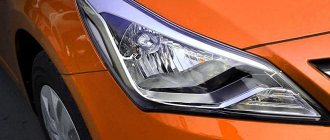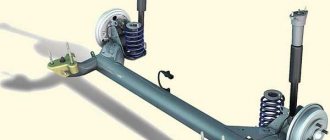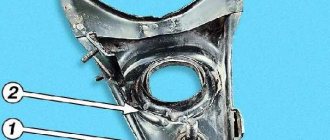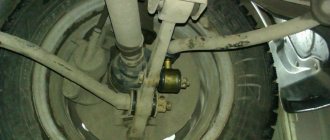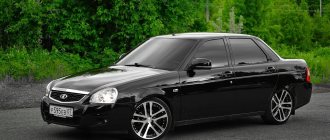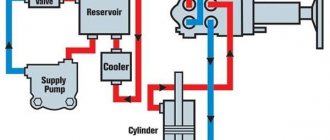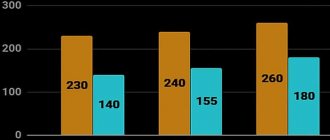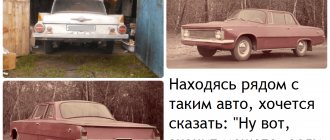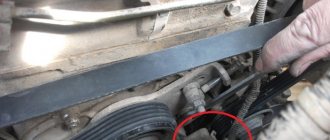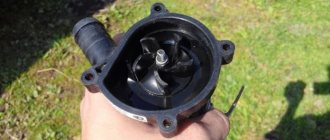After some period of operation of this car, its owners begin to be interested in upgrading the Hyundai Solaris suspension. This brand of Korean car has become popular in many regions of the Russian Federation and CIS countries in a very short period. The beautiful appearance of this car and its good performance characteristics attract many potential buyers. Despite many positive factors, many owners do not stop with the purchased product, but try to change its quality for the better.
Upgrading the Hyundai Solaris suspension with your own hands is quite possible, you just need to approach this issue competently and responsibly. Problems with the suspension appear mainly when traveling on bad roads, which is why the question arises about the possibilities of its modifications. Changes can be different, depending mainly on the capabilities and requirements of the car owner.
A few words about the problems
A lot has been said about the shortcomings in the design of the rear suspension of this car for a long time. The manufacturer assures that in the latest models all the wishes of the owners have been taken into account and corrected, but models of earlier releases need changes. The most complaints come from owners about the car's yaw when driving at speeds from 80 km/h to 140 km/h. As experts have found out, the reason for this is the poor design of the rear shock absorbers.
We all understand perfectly well that there is no such thing as an absolutely ideal car, but we want to have a car with as few shortcomings as possible. After a certain period of operation, the wheel bearings become weak and the steering rack of the car begins to make unpleasant sounds. Because of this, the steering wheel begins to beat, and the steering tips quickly become unusable. In order to somehow get rid of this, its elements are being improved.
Design improvements
But it’s good that Hyundai’s management treats its work reasonably and rationally: the company many years ago established feedback with consumers in order to know all its shortcomings and fair criticism from customers, in order to correct shortcomings in the future and not fall under an avalanche of popular indignation.
Thus, having received complete information about the preferences of drivers, the Koreans are launching the next generation of the model in 2014, in which the main emphasis was placed on the Hyundai suspension. The concern announced the work done a year before the official release of the updated version. All major auto publications spread this news, so it was difficult to find a motorist who had not heard about the upcoming premiere. Hyundai fans waited with bated breath to see what would happen this time.
To their great joy, the company did not destroy any illusions or dispel good ideas. The car turned out to be even more colorful than before, but most importantly, it really became more practical and durable. The front and rear suspensions of the Hyundai were changed, new engines appeared that developed dizzying speeds, and the car became more functional.
Now the Hyundai front suspension is a unique MacPherson strut design, it ensures reliability, driving safety, good stability, road grip, and handling. The rear suspension is represented by a semi-independent spring, it is responsible for the softness and smoothness of the ride: on a good road and at an impressive speed, it seems that the car is simply taking off, it moves so easily and naturally.
To give Solaris dynamics, engineers paid special attention to shock absorbers; in the new version they turned out to be more energy-intensive than in previous generations, and were developed with the active participation of the Mando company. Shock absorbers and springs received parameters of greater rigidity, which had a positive effect on the car’s ability to move on bad roads.
If earlier it began to desperately rattle at every bump, now it drives quietly and smoothly. Road irregularities that do not fall into the extreme category now go completely unnoticed by the Solaris driver. Just a few years ago this could only be a dream. The rocking motion has also become smoother, so you won’t get motion sickness in a car; this is especially important for people with increased sensitivity and not the best vestibular apparatus. Photos of suspension parts can easily be found on the Internet.
What can be done?
In most cases, many begin to improve the stability of this car when driving at high speeds. As noted earlier, the most complaints are caused by the yaw of the rear of the car, pulling to the side when there are side gusts of wind or heavy vehicles passing by. All this was a design flaw, which is quite possible to correct on your own. The main culprit for these problems is an incorrectly selected angle of installation of the rear shock absorbers.
Black list of shock absorbers
Manufacturers to avoid. These brands are mainly used by resellers and people who do not understand spare parts. Sometimes the reseller doesn’t even have time to sell the car before the shock absorbers need to be changed again.
AMD AMDSA314 shock absorbers
Shock absorbers ARIRANG ARG261124
Shock absorbers PARTS MALL PJAR065
Shock absorbers PATRON PSA534002
Shock absorbers STELLOX 42039660SX
Shock absorbers SAT ST553004L002
Finally
We will not dwell on the issue that only high-quality spare parts should be used. In some cases, especially on cars with high mileage, the quality of the parts used alone increases the controllability, stability and other characteristics of the car. Fans of traveling at high speeds install a stabilizer bar on the rear axle, which, after minor modifications, is used from domestic cars with front-wheel drive VAZ 2108.
As can be seen from our story, there are opportunities for improving this car model. We tried to tell everyone how the Hyundai Solaris suspension is modernized. Assess your technical and financial capabilities for such work and only then get to work.
Checking the technical condition of rear suspension parts on a car - Hyundai Solaris
Carry out all checks and work from below the car, mounted on a lift or inspection ditch (with the rear wheels hanging).
Find out if there are any cracks or traces of contact with road obstacles or the body on the suspension parts, or deformation of the rear body parts in the places where the suspension units and parts are attached.
Check the condition of rubber-metal hinges (silent blocks), suspension springs and shock absorbers.
Rubber-metal hinges and rubber parts must be replaced in case of ruptures and one-sided bulging of rubber, as well as when their end surfaces are trimmed.
Suspensions on rubber parts are not allowed:
- signs of rubber aging;
- mechanical damage.
The following are not allowed on rubber-metal hinges:
- signs of aging, cracks;
- one-sided bulging of the rubber mass.
Replace defective parts.
Check for mechanical damage (deformations, cracks, etc.) to the suspension elements.
When checking, carefully inspect the following.
1. Rubber bushings and tightening of threaded connections of the lower...
2. ...and the upper shock absorber mounts.
3. Check the condition of the shock absorber protective covers.
4. Lower the boot and check the shock absorber rod. Liquid leaks along the rod are not allowed.
5. Rubber-metal hinges (silent blocks) of the rear suspension beams.
6. Rear wheel hub bearings.
7. Springs and compression buffers for the rear suspension.
What is the rear suspension of the Hyundai Solaris? The question is quite interesting. To understand the principle of its operation, you need to understand the device. This article is devoted to this issue. After familiarizing yourself with it, you may learn how to disassemble the car suspension yourself.
Components
The rear suspension allows the car to move smoothly and softens road imperfections. It must be admitted that the design of the front suspension is more complicated than the rear one, however, in this case, you also need to figure it out. Its design is as follows:
- The main element is the beam.
- Lever attachment.
- A device that acts as a stopper for a spring during compression.
- Shock absorber.
- Lever arm.
- Hub assembly.
- Pad located underneath the spring.
- The spring itself.
- Lining located on top.
- Buffer washer.
- Thrust element.
The Hyundai Solaris uses a semi-independent suspension, with an elastic beam type, as well as a spring suspension with installed shock absorbers.
The levers are equipped with edges on which the wheel axles, individual brake elements and support clamps are directly attached. In front, the levers have welded bushings in which silent blocks are located, which act as a connecting part between the body and the beam. As for elastic parts, in this case their role is played by springs.
In the Solaris suspension, it is worth highlighting the fact that the spring rests directly through the gaskets of the rubber sample. Another characteristic feature of this car is the smaller diameter of the lower turn compared to the uppermost one.
In any suspension, springs are usually divided into classes, depending on their stiffness parameters. To determine the class, the specific color of the part is used. Naturally, on both sides you need to use springs of the same class and the same model. During replacement, it is not recommended to install elements different from those that were installed previously. The role of the limiter during compression is performed by the buffers listed in the list under No. 3. They are installed in the middle of the upper support.
The shock absorbers have special eyes both at the bottom and at the top. Hinges made of rubber and metal are pressed into them. Inside the hinge there is a bushing through which a bolt is inserted, allowing you to attach the shock absorber to the body. The front suspension of the Hyundai Solaris is equipped with a bearing located in the hub unit. The advantage is that there is no need to regularly add lubricant to it. If the device fails, it is simply replaced.
Shock absorber parts
Shock absorber boot. It is not listed separately in the catalog. It only comes complete with a shock absorber. Despite the fact that the boot is plastic, a situation where it ruptures before the shock absorber and loses its properties does occur, although more often the opposite happens.
Upper bushing or silent block of the shock absorber. The original is also only assembled. It is made separately only by the company Point of Support. Material polyurethane.
Article 12-06-3667
Lower bushing or silent block of the shock absorber. Everything is the same as with the top.
Article 12-06-3668
Upper shock absorber bolt. It may sour tightly inside the metal bushing of the shock absorber. In this case, it will have to be cut off and replaced with a new one.
Article 553932K000
Shock absorber lower bolt. The same thing can happen with the bottom bolt.
Articles: 55117-0Q100 and 55117-1M000
Shock absorber nut.
Article 552592M000
Additional Information
Based on the data provided, one can guess that dismantling and installing individual suspension parts in a Hyundai should not cause difficulties. The main thing is to have the proper equipment.
Today, many craftsmen are engaged in refining the suspension. Such work involves installing new parts of higher quality. They often install reinforced springs, based on the fact that domestic roads cannot boast of high quality.
It is appropriate to modify the suspension only if there is a need for it. For example, when the car has to drive on bad roads.
As a rule, pointless suspension upgrades lead to increased costs, and there is no point in spending money just like that.
Theme Options
Search by topic
Display
- Linear view
- Combined view
- Tree view
Suspension
Most car enthusiasts independently modify the rear suspension of the Solaris.
Such an event involves the use of high-quality parts. In some cases, car owners install reinforced springs, which is quite justified based on the unsatisfactory quality of the road surface in the Russian regions.
Improvement of the Solaris rear suspension
It only makes sense to do it when necessary.
Such cases include constant operation of the vehicle on poor road surfaces or in off-road conditions. Unreasonable strengthening of the Solaris rear suspension
usually leads to unnecessary financial costs; spending money in this case is pointless and ineffective.
993
Choice
The first shock absorbers were produced as the softest L - 000, the second with the designation L - 001 at the end of the part number (appeared after 2012), began to be designated with a yellow mark, they became 10% stiffer in compression. The third version of shock absorbers (front and rear) began to be designated with a green mark. They have become even stiffer both in rebound and compression. The last change occurred in 2014, where “reinforced” front springs and struts were installed.
At the factory, the Hyundai Solaris is equipped with shock absorbers from the Korean company Mando; they are sealed, resistant to temperature changes, and in addition, they provide a relatively low spread between the rebound and compression forces.
